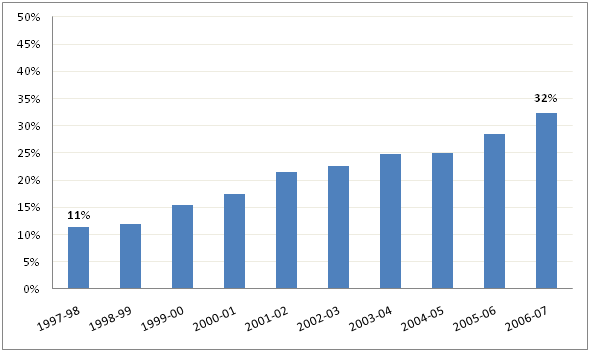 Legislators and education administrators claim that higher income families can afford tuition hikes, and that lower income students will receive increased financial aid, both from the state and from new federal policies. However, the evidence suggests that injecting a market-driven model of financing into the public sphere of education will lead to a lack of access for low-income students.
Legislators and education administrators claim that higher income families can afford tuition hikes, and that lower income students will receive increased financial aid, both from the state and from new federal policies. However, the evidence suggests that injecting a market-driven model of financing into the public sphere of education will lead to a lack of access for low-income students.
The claim that high-tuition/high-aid financing models actually work to the benefit of low-income students is contradicted by data from schools where such a model has already been implemented. At the University of Michigan-Ann Arbor (UM), disadvantaged students have lost rather than gained ground since the university switched to high-tuition/high-aid.
From 1997 to 2007, the portion of UM students coming from lower- and middle-income households has remained disproportionately small. In 2007, just 26.6% of entering freshman came from families with incomes under $75,000, compared to 62.3% of Michigan families with incomes below that level. In 1997, 34.6% of students came from families with incomes under $75,000, at a time when 64.4% of U.S. families had incomes below that level.
Despite great efforts to recruit more students from underrepresented minority groups, the percentage of black students enrolling has decreased from 8.4% in 1999 to 6.7% in 2008, and Latino and Native American percentages have remained stagnant. In addition, the proportion of first-generation college students has decreased from 15.7% in 2004, to 11.4% in 2007, shrinking that cohort by more than 27% in just three years. These statistics all paint a picture of decreased economic and racial diversity at the UM after switching to the high-tuition/high-aid model.
In the search for an explanation, UM Executive Financial Aid Director Pamela Fowler refers to the phenomenon known as “sticker shock”: “Our cost scares people away… it’s hard for [prospective students] to reconcile that, yes, we may be more expensive, but we give more financial aid.” High “sticker” prices – total tuition amount before financial aid – deter students from enrolling for reasons including lack of knowledge about available aid packages, fear of incurring large sums of debt, or fear of burdening their families.
The University of Miami-Ohio witnessed the effects of sticker shock just one year after making the switch to the high tuition/high aid model in 2004. The school experienced a record 13% drop in in-state and 10% drop in out-of-state enrollment, with the decreases coming disproportionately from “highest need” students. This outcome came as no surprise of researchers who have long been examining the relationship between tuition and access. Studies have shown that states with higher tuition have lower rates of enrollment of low-income students and wider gaps in enrollment rates of high and low-income youth. The most recent data point to a general trend of 6% decrease in enrollment of undergraduates for every $1,000 increase in tuition at top public research universities.
In response to such studies, as well as to the negative consequences experienced at Miami-Ohio, Ted Strickland, Governor of Ohio, set a freeze on higher education tuition prices in the state of Ohio in 2007. In exchange, the state increased its appropriations to higher education by 13% over two years. Similarly, the state of Maryland has also employed a tuition freeze. In 2005, Maryland’s college tuition rates were 6th most expensive in the nation. After four consecutive years of tuition freezes, accompanied by a 33% increase in state appropriations, Maryland succeeded in pushing its rank down to 16th in 2008. Although tuition freezes like these are only temporary measures, they reflect a strong desire from states to address the issue of higher education accessibility for its residents.
At the University of Washington, data show a trend of decreasing economic diversity corresponding with rising tuition rates even before the major tuition hikes scheduled for the next two years. While income data at UW is limited to those students who apply for financial aid, it is still possible to see that UW is increasingly becoming a place for students with higher-income backgrounds. Between 1997 and 2007, the percentage of freshmen applying for aid consistently hovered at around 63% of the incoming class. Of those 63%, roughly one in ten reported an annual family income of over $100,000 (adjusted to 2007 dollars) in 1997, by 2007 it was one out of every three students.
Percentage of Incoming University of Washington Freshman Applying for Aid with Incomes Over $100,000

Source: University of Washington’s Office of Institutional Research
Note: This is the third in a five-part series based on EOI’s latest report: Losing By Degrees. View part 1 here, part 2 here.
More To Read
March 24, 2025
Remembering former Washington State House Speaker Frank Chopp
Rep. Chopp was Washington state’s longest-serving Speaker of the House
February 11, 2025
The rising cost of health care is unsustainable and out of control
We have solutions that put people over profits
January 29, 2025
Who is left out of the Paid Family and Medical Leave Act?
Strengthening job protections gives all workers time they need to care for themselves and their families
